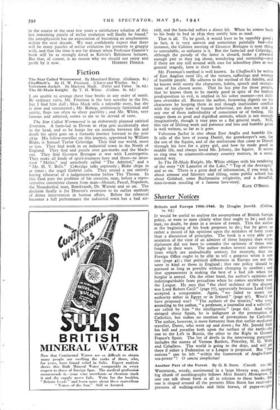The Source of the Sun ' s Energy WE know something about
all that concerns the sun except two things—its birth and its death—and it is these exceptions that Professor Gamow has chosen as the ostensible subject of his very interesting book. It should be said at once that he gives very little space to them. The reader will find here a clear and trust- worthy account of present-day views of the possible transforma- tions of atoms, of the present condition and most probable past and future history of the sun and the stars, and of the structure and behaviour of the whole material universe so far as we know it. From all this the passage to speculation about how the sun began and how it will end is not entirely blocked, and Professor Gamow lets us see the direction it takes. His style :s conversa- tional—good-humoured and witty—and the treatment is enriched by a wealth of original diagrams. Altogether, one could not wish for a better account of the solar physics of the moment. With a proviso to be mentioned presently it can be recommended to the attention of all and sundry.
Ever since the principle of conservation of energy has been accepted, the great problem of stellar evolution has been : where do the stars get the energy which they pour out continuously into space? For some time it has been believed that the only possible source must be the nuclei of atoms, but until recently we have known nothing of the conditions necessary for the liberation of sub-atomic energy. Today, thanks to the progress of physics, the veil has been lifted a little, and we can now imagine several series of processes (partly realised in physical laboratories) which would result in a steady transformation of sub-atomic energy into radiant heat and light. Each series depends on the existence in the star of excessive quantities of hydrogen. For example, in the sun the combination of hydrogen with carbon starts a series of changes, at the end of which the carbon-nucleus is restored to its original condition, the hydrogen has disappeared as such, and nuclei of helium together with short-wave radiation are created. The process can then be repeated over and over again so long as there is enough hydrogen left.
The sun, on this view, is still getting hotter, and will do so for well over ten thousand million years yet, so that " instead of being frozen to death by the decrease of solar activity, life on earth is rather doomed to burn out because of the intense heat which will be developed by our sun toward the end of its normal evolution." This programme may, it is true, be modified by a sudden explosion which may occur at any moment and destroy us instantaneously, but on the whole it would be unwise to allow this possibility to influence our ordinary human activities.
There is one point on which a word of warning is necessary. When a mathematical physicist says that a theory is proved, he means that it is the only theory yet devised which is not incon- sistent with known facts or with the general body of accepted physical theory, and is therefore the only theory on which it is reasonable for him to work. The non-scientific reader, however, is apt to think that when he says the theory is proved he means the theory is proved. It is a bad mistake, but not ari entirely inexcusable one, and since Professor Gamow undertook to write for the general reader he should have foreseen that it might arise and have taken the necessary precautions. It should be said, therefore, that in spite of such remarks as " it may be hoped that in the course of the next few years a satisfactory solution of this last remaining puzzle of stellar evolution will finally be found," the astrophysicist has no expectation of becoming an anachronism within the next decade. We may confidently expect that there will be many puzzles of stellar evolution for posterity to grapple with, and that the time is not far distant when Professor Gamow's book will be as strongly dated as Kelvin's Baltimore lectures. But that, of course, is no reason why we should not enjoy and































 Previous page
Previous page